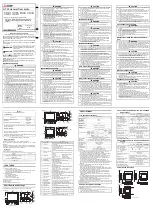
PAN1322-SPP
ENW89841A3KF
User’s Manual
44
Revision 1.3, 2013-08-14
Hardware Description
Assembly Guidelines
10.9
Voids in the Solder Joints
10.9.1
Expected Void Content and Reliability
The content of voids is larger on LGA modules than for modules with BGA or leads. At a LGA solder joint the
outgassing flux has a longer way to the surface of the solder and it has a relatively small surface to the air.
The void content of the PAN1322 module conforms to IPC-A-610D (25% or less voiding area/area).
shows an example of void-content at a module assembled at production site. Normally you can see the
whole spectra of void content variation within the same lot and occasion of assembly.
Voids _I P C _A_ 610D .v s d
Figure 20
X-ray Picture Showing Voids Conforming to IPC-A-610D
10.9.2
Parameters with an Impact on Voiding
If the void content has to be reduced following parameters have an impact.
Solderability on module and PCB
Bad solderability is often connected to oxidation and has therefore a major impact on voiding. Flux will get
entrapped on oxidized surfaces. In general, Ni/Au pads show fewer voids than HASL and OSP.
Solder paste
Higher activity of the flux will remove oxide rapidly and less flux will get entrapped.
Voiding increases with increasing solder paste exposure time, since long exposure time will result in more
oxidation and moisture pickup.
Pad size
A large soldering pad means that the outgassing flux has a longer way to the surface of the solder, and will thereby
create more voids.
Solder paste
Smaller powder size and higher metal load means more metal surface to deoxidize and thereby more entrapped
flux and voiding. Higher metal load does also mean higher viscosity and more difficult for outgassed flux to remove
from the solder.









































